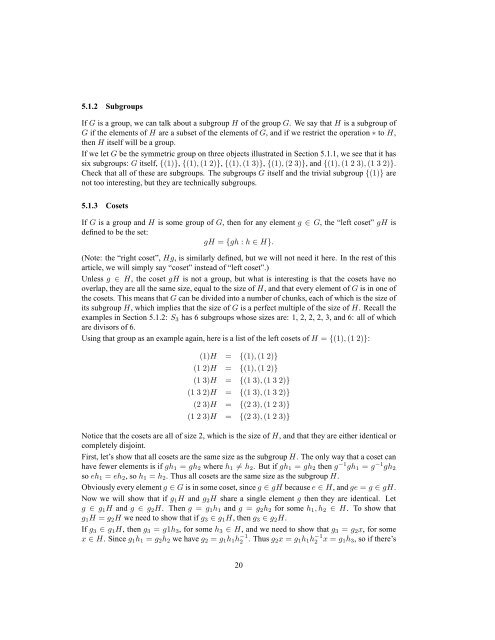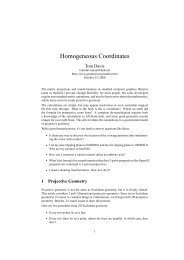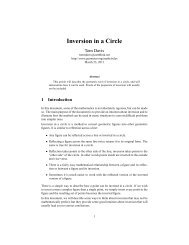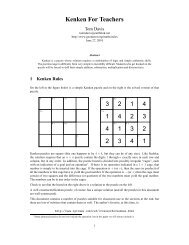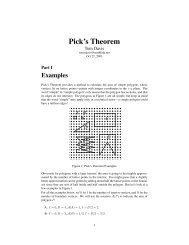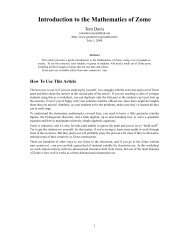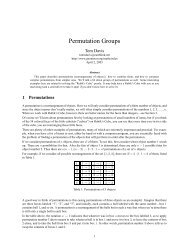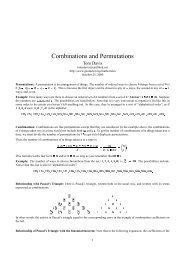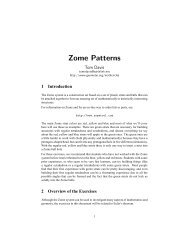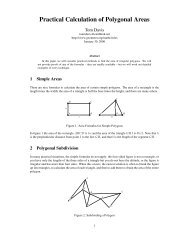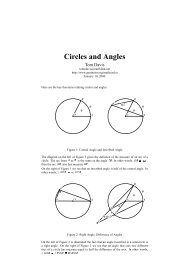P´olya's Counting Theory - Home Page -- Tom Davis
P´olya's Counting Theory - Home Page -- Tom Davis
P´olya's Counting Theory - Home Page -- Tom Davis
Create successful ePaper yourself
Turn your PDF publications into a flip-book with our unique Google optimized e-Paper software.
5.1.2 Subgroups<br />
If G is a group, we can talk about a subgroup H of the group G. We say that H is a subgroup of<br />
G if the elements of H are a subset of the elements of G, and if we restrict the operation ∗ to H,<br />
then H itself will be a group.<br />
If we let G be the symmetric group on three objects illustrated in Section 5.1.1, we see that it has<br />
six subgroups: G itself, {(1)}, {(1), (1 2)}, {(1), (1 3)}, {(1), (2 3)}, and {(1), (1 2 3), (1 3 2)}.<br />
Check that all of these are subgroups. The subgroups G itself and the trivial subgroup {(1)} are<br />
not too interesting, but they are technically subgroups.<br />
5.1.3 Cosets<br />
If G is a group and H is some group of G, then for any element g ∈ G, the “left coset” gH is<br />
defined to be the set:<br />
gH = {gh : h ∈ H}.<br />
(Note: the “right coset”, Hg, is similarly defined, but we will not need it here. In the rest of this<br />
article, we will simply say “coset” instead of “left coset”.)<br />
Unless g ∈ H, the coset gH is not a group, but what is interesting is that the cosets have no<br />
overlap, they are all the same size, equal to the size of H, and that every element of G is in one of<br />
the cosets. This means that G can be divided into a number of chunks, each of which is the size of<br />
its subgroup H, which implies that the size of G is a perfect multiple of the size of H. Recall the<br />
examples in Section 5.1.2: S 3 has 6 subgroups whose sizes are: 1, 2, 2, 2, 3, and 6: all of which<br />
are divisors of 6.<br />
Using that group as an example again, here is a list of the left cosets of H = {(1), (1 2)}:<br />
(1)H = {(1), (1 2)}<br />
(1 2)H = {(1), (1 2)}<br />
(1 3)H = {(1 3), (1 3 2)}<br />
(1 3 2)H = {(1 3), (1 3 2)}<br />
(2 3)H = {(2 3), (1 2 3)}<br />
(1 2 3)H = {(2 3), (1 2 3)}<br />
Notice that the cosets are all of size 2, which is the size of H, and that they are either identical or<br />
completely disjoint.<br />
First, let’s show that all cosets are the same size as the subgroup H. The only way that a coset can<br />
have fewer elements is if gh 1 = gh 2 where h 1 ≠ h 2 . But if gh 1 = gh 2 then g −1 gh 1 = g −1 gh 2<br />
so eh 1 = eh 2 , so h 1 = h 2 . Thus all cosets are the same size as the subgroup H.<br />
Obviously every element g ∈ G is in some coset, since g ∈ gH because e ∈ H, and ge = g ∈ gH.<br />
Now we will show that if g 1 H and g 2 H share a single element g then they are identical. Let<br />
g ∈ g 1 H and g ∈ g 2 H. Then g = g 1 h 1 and g = g 2 h 2 for some h 1 , h 2 ∈ H. To show that<br />
g 1 H = g 2 H we need to show that if g 3 ∈ g 1 H, then g 3 ∈ g 2 H.<br />
If g 3 ∈ g 1 H, then g 3 = g1h 3 , for some h 3 ∈ H, and we need to show that g 3 = g 2 x, for some<br />
x ∈ H. Since g 1 h 1 = g 2 h 2 we have g 2 = g 1 h 1 h −1<br />
2 . Thus g 2x = g 1 h 1 h −1<br />
2 x = g 1h 3 , so if there’s<br />
20


